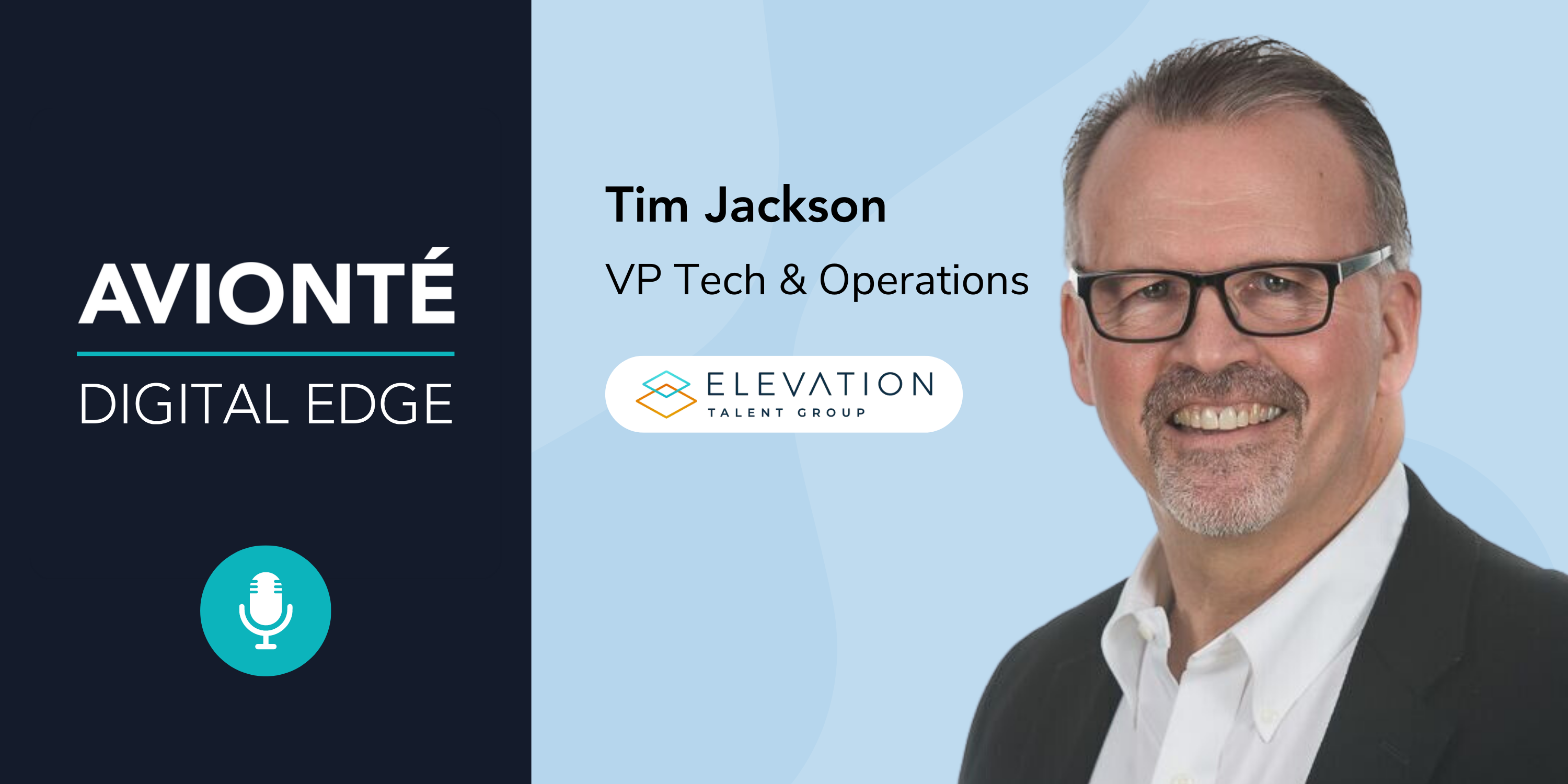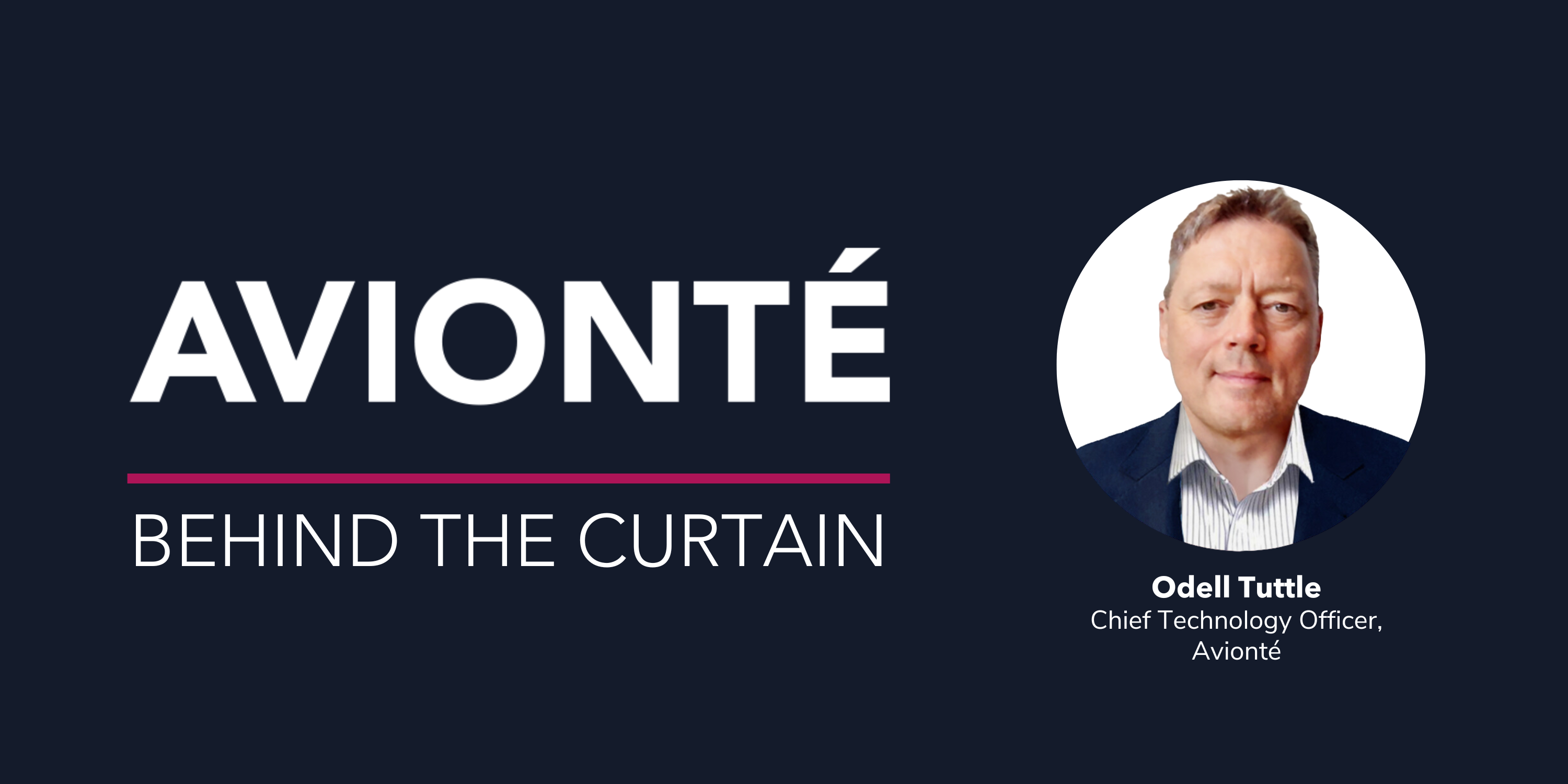Within the staffing industry, the emergence of managed service providers (MSPs) and vendor management systems (VMS) has sparked debate with many seeing them as adversaries to traditional staffing practices. However, a paradigm shift driven by labor cost optimization strategies, originally developed for complex healthcare systems, is now fueling the widespread adoption of MSPs and VMS interfaces among employers across all industries. As a staffing agency, it’s crucial to understand the risks and opportunities presented by the modern workforce supply chain.
In this episode of Avionté: Digital Edge, Chris Ryan, Chief Marketing and Strategy Officer at Avionté, sits down with Tim Jackson, Vice President of Tech And Operations for Elevation Talent Group, to discuss how to apply the same principles of supply chain management to a modern workforce to ensure quality, continuity, and cost, as well as what it means for the contemporary staffing agency that needs to operate within a modern workforce management system.
This is a partial transcript of the full conversation. Listen to the podcast episode for the complete discussion.
Chris: What got you interested in human capital and workforce management, and how did you get into healthcare staffing?
Tim: I got into healthcare staffing from my involvement with a professional staffing firm, The Advanced Group in Chicago. I had joined them after a 20-year career in finance and technology, and they had a really unique business model in the healthcare staffing space. Essentially, they were committed to running MSPs and this firm had 12 MSPs in the Chicago metro market. We dominated that market as the MSP provider and, in doing so, we essentially demonstrated how a staffing firm could make a lot of money and, at the same time, serve their clients and raise patient care.
Chris: So, it sounds like if you wanted to provide healthcare temporary workers in Chicago, they were going to work with your organization exclusively. Is that fair?
Tim: That is fair. Ah, you know if anybody’s listening who’s familiar with the MSP model, they can be quite controversial because an MSP can be disruptive to traditional staffing. But it was my involvement with the MSP process that got me into workforce management, because in trying to meet the needs of these clients, I got exposed to several large systems across the country. And we understood better what was required to meet the needs of large hospitals and large hospital systems than they were.
And they, of course, were practicing a level of workforce management and had been using least-cost optimization models, really well developed from the advisory board which was a healthcare consulting firm.
And their models were very well articulated about what it meant to have the right amount of staff, and essentially explained how you can actually use temporary labor for a hospital and not only maintain patient care standards, but actually reduce your costs and improve your own workforce by essentially reducing some of the pressure on your incumbent staff to pick up missed shifts and to pick up shifts that were difficult to fill. So, it was this exposure to hospital systems that I said okay, there’s a science here and the labor supply chain emerged out of that as a model for workforce management in health care.
Chris: What is it about health care that lends itself to early adoption of an MSP model? Is it the credentials that are required for healthcare positions? Is it cost and quality?
Tim: All of the above. But most importantly I think the cost of failure is so high in health care where if you don’t have the right staff on the floor, you put patient care at risk. And for many hospitals that means you can’t accept new patients. There are models where census is rising at a hospital. If you don’t have the labor to support it, you can’t take those patients in. And that ultimately disrupts the financial model of the hospital whether it’s for profit or not-for-profit.
Chris: Ultimately, operational continuity is critical to the value proposition of what you’re delivering? So, let’s talk a little bit about supply chain. You wrote this blog, and I’m really curious: what exactly do you mean when you talk about labor as a supply chain? What is a supply chain? How does a labor supply chain differ from the traditional supply chain that we might use for products?
Tim: The fundamentals of a supply chain begin with the concept of demand planning. And this is your production or your service delivery plan. And our ability to do demand planning, to then have sourcing, supply pipelines, to understand what substitutes are available and the consequence of supply disruptions. To me, those are the elements that we start with.
But I’ll go even further. If you’ve ever worked in an industrial process, you know that there’s something called receiving operations, and the truck backs up and goods are taken off a truck and inspected. Well, we don’t do that when it comes to people, but we surely have an onboarding process that is analogous to that.
And so, if you take the material supply chain and just array it across the whiteboard, right below it you could write the labor version of that tech process. So, it goes from demand planning to all the procurement processes. Anybody who’s in this business knows how kind of difficult it is to become a supplier to a healthcare enterprise.
And it’s not just because the competitions there. It’s because the bar gets set high in terms of having you enter a hospitals or health systems supply chain. The point is that there is a supply chain there. If you were selling tires for your auto plant, you would have a purchase order, you’d have a receiving document from the warehouse, and you’d have an invoice. Those three things have to match before I pay you. Well, the same thing happens in staffing. We’ve got these time sheets. We’ve got invoices. We’ve got schedules. All those things need to be validated before the person releases the payment. And finally the last piece in supply chain, which I think should resonate with all of us, is managing your inventory wear and tear. You know it’s one thing to talk about it in the context of a physical good. We need to be cognizant of the burdens we put on the people, of the wear and tear and the job place stress.
The newspapers are filled with stories associated with COVID issues related to health care. Healthcare workers who are used to delivering the best care possible for 10 patients had to deliver adequate care for 20 patients or sometimes not as adequate care for 30 patients. That wears on people. And so you have to pay attention to the inventory in a labor supply chain.
Chris: You’re basically saying the supply chain, whether it’s people or whether it’s products, all of the same principles apply and you are managing cost, quality. You’re managing your inventory constantly. There really is no difference in it.
Tim: So cost, timeliness, and quality are the three things that need to be managed in a physical supply chain, as well as a labor supply chain. Those are the variables that we, as managers, get to work with. The principles of just in time supply apply to labor supply too. We have float pools; we have a queue of people that are being onboarded this month for deployment next month; we’ve got travelers rolling off that we’re going to bring back our people on. There’s just all sorts of complexity to this. And when we talk about quality, you break quality down in a lot of different ways to skills, not only the clinical skills but the technical skills associated with all the hardware that exist in hospitals. And having our staff being able to deal with the EMR systems that are out there, and am I able to use those tools quickly?
The jump between Cerner and Epic might take a little bit more training, but those are things that matter when it comes down to onboarding, and frankly, the cost of bringing someone in. So, you’ll see on a requisition from a client hospital very detailed specifications about the healthcare workers’ technical competencies in, the EMR systems, as well as certain diagnostic tools.
Chris: So how does the concept of a supply chain for labor really address the challenges and demands of a workforce? A lot of our listeners aren’t necessarily in healthcare staffing. They may be in another part of staffing, and so they’re wondering: I don’t have to listen now because I do clerical and light industrial staffing or I do hospitality staffing or I do professional staffing. Why does the staffing industry need to pay attention to what has been happening in health care and what is the underlying lesson there?
Tim: I do see it in the light industrial space, and that includes not only assembly, but warehouse operations. You look at seasonal variation in product demand from holidays to just a summer or winter. Those all have a production model that preceded delivery to the consumer. And that production included not only materials but labor. And so, Macy’s needs 3000 people available to them in the Chicago northern suburbs to deploy across all their stores. That’s a demand requirement that needs to be modeled. As a staffing firm, if I’m used to providing retail support in that market, I know I better be building my queue and create these curated lists of skilled talent that’s ready to go to work.
If I’m doing hospitality, energy workers, construction workers and something as simple as school substitute teachers, there’s a seasonality to that demand. You know the gaps and if I’m the staffing firm running the substitute teacher solution for a school district, I need to be managing that and building my queue. That function of labor supply chain workforce management is not new. Good managers, good operators have been doing it for years.
Why do we want to do that? Because we can learn something from the direct material guys. The direct material people are focused on metrics, are focused on data. And allowing our workforce planning models to be informed by data is to me kind of the threshold. I want to be able to have that conversation with my client. I want to understand what his problem is and be able to talk about it in the context of data. And the minute I do that I’ve elevated myself above the competition.
Chris: It sounds like if you want to be a strategic partner to your employers, the first and most important thing you need to do is understand their demand, anticipate it, and then work backwards.
Tim: And it works for every niche. There’s not a single niche in our business that doesn’t have these dimensions. It’s just a matter of being able to talk to the detail of it. And the more we as a staffing provider are engaging with that client, the better product we create and ultimately sell.
If you were the CEO of a firm that’s running HR for a chain of fast-food operators here in Chicago, I’d be talking to you about the ability to have people land in your workforce and be effective members of your team week over week. And, we would have conversations about what works and doesn’t work. There’s more conversation now around, “Hey, what did we do wrong? Maybe we have some accountability for the success of this worker in our orientation, in our onboarding processes.” And that’s a great step.
Chris: So, let’s talk a little bit about some of the components and stages that are involved in managing a labor supply chain. What is it exactly that I’m going to need in order to build a supply chain? And where does an MSP or VMS technology fit into labor supply chain management?
Tim: I don’t think there’s a lot of substitutes for a good VMS system, whether you structure that VMS system inside an MSP relationship or you’re the ultimate employer. If you were a hospital, or if you were running the car assembly plant in Charleston, South Carolina, you can bet that there is a VMS. So, the VMS plays a key role as a procurement system for labor, and I have a bar to reach for qualifying as a supplier. There’s all sorts of benchmarks around that. There’s agreed-to pricing. There’s agreed-to quality standards. There’s agreed-to timeliness, and these VMS systems provide me, the employer, a way to establish those criteria and communicate them to my supply chain and to my suppliers and use that back and forth to say what’s working, what’s not working.
So, if you look at good workforce management systems, you’re going to see there are suppliers who’ve embraced this process and are able to use the technology appropriately to get requisitions from the VMS system in a timely manner. As well as quality feedback around workers, time sheets, time reporting.
Chris: So, Tim, if I’m a staffing agency, the VMS is often seen as the enemy. It’s just a way that an employer is going to try and shave a couple points off of my fees as a staffing agency. But you’re saying the VMS is kind of inevitable and more and more employers are going to adopt VMSs. Is that your point of view?
Tim: That would be my view. So, the sweet spot for a VMS system is to not break that hiring manager visibility and to allow the system to gather data, not be a blocker for certain staffing firms. When I hear of a staffing firm that is using their VMS, and always taking the first person submitted, to me they’re making a mistake. There needs to be a quality differentiation for hiring managers who are putting people to work, especially in health care where the cost of failure is high. I can’t afford to bring someone in and have them not work out. I want them to work out, so I need to do some level of screening. So, if I’ve got a submittal, I’m just not taking the first one. I’m going to look at an array of people. I’m going to make sure I gave myself time to look at these people, so I’m not in a crisis situation.
Now, in the context of a per diem float pool operation, time becomes really short. So, the way around that is we prequalify people. I know that they’ve been orientated to my facility. They’ve been trained. They know how to work in my facility. They’ve had good references from my team captains on the floor. If I’m a staffing firm, I’ll take that game anytime you give me a chance to qualify my people, orient them to the unit, make sure they’re ready to go, and then I’ll run them as my pool, because I’ll be putting work at other locations in this market.
Chris: So, let’s talk about the potential opportunities and risks for staffing agencies, not just in health care, but as a lot of other areas start to adopt a supply chain approach to labor? How is that going to change the how you compete as a staffing agency? Are employers going to start looking at different vendor selection criteria? Does the staffing agency need to develop different capabilities? Do the workflows change? Are we selling and marketing differently? What does that do to staffing?
Tim: This is frankly where staffing firms need to look to firms like the big ATS providers to help us with the integrations. I think these integration opportunities in the VMS space are really important.
Chris: Talk a little bit more about that. What does a good integration opportunity look like, and how can that benefit both the staffing agency and the employer customer?
Tim: It starts with requisition distribution. I’ll go back to manufacturing for a minute – and demand plan. We have a thing called the MRP, manufacturers resource planning, and that would throw off a requisition to the warehouse to say bring me these goods. In the hospital system, that MRP gets run off the bed system, so that scheduling office knows there’s a requirement there. As soon as the client knows they have a demand, that should be distributed to me as a supplier. I can do a better job if I have more lead time. So, requisitions have to be timely and complete. Give me enough information to actually do something with it.
The second is, as a supplier, I need to be able to submit my talent, and, essentially, if I submit that talent, I know I’m going to get that fill, especially in the per diem space. I’m going to be able to submit people electronically. So, I’m sitting at my ATS. I hang up the phone with a nurse. I know they’ve got the availability; they’ve got the skills to match. I want to submit them, and I hit that button.
I don’t want to have to create a submittal form. If I got the req from the MSP, I’m going to push my submittal into the MSP automatically. And the client then sees it pop up on their side. In the best VMS systems, they’re able to then either schedule an interview or schedule a start and that communication comes back to me as a staffing firm. I’m able to then communicate with my worker and they’re going to get that on their phone and say hey, “Tim, you’re starting Saturday at ABC at nine am. Get ready.” And I got that notice on my phone, and I can acknowledge it. And all of that process paperwork is shrunk.
Chris: So, there’s a possibility of streamlining a digital transaction that starts as a requisition in a VMS, goes all the way through to the mobile talent platform, and then back to the VMS? If you could make wave a magic wand, that’s exactly the kind of system that you would want to build.
So, in an ideal world, a staffing agency has a great relationship with their talent, but then they are using demand planning and the VMS with their employers to create a sticky relationship with them as well.
Tim: And that mobile platform completes the picture if you would. And then, of course, time gets processed that way, I can see all my benefits, and so on.
Chris: You’re saying VMSs are here to stay. They don’t have to be your enemy. They can work for the staffing agency as well. As for the employer, if they are done right, being able to proactively plan in advance for the needs your customers is a critical part of how a staffing agency would compete going forward. Those are all things that I think I’ve heard you say and that make a great deal of sense to me.
And then, what I also heard you say, is ideally from a software and technology standpoint, we should be looking for ways that a VMS and an ATS be able to talk seamlessly with one another, and to pass through all the way to the mobile talent experience and back.
Tim: Bingo!
Guest
Tim Jackson
VP, Technology & Operations at Elevation Talent Group
Tim is a principal in a staffing start-up, Elevation Talent Group, and consults with executives in the staffing industry to maximize the effectiveness of their teams and technology investments. His broad functional, financial, operations and technical experience in staffing helps him match up with these leaders. Tim built his consulting practice on 20 years of professional staffing experience and 25 years of banking and corporate finance experience. Tim’s focus is on tech stack optimization, straight-through processing for PayBill operations, recruiting operations, building new systems and standing-up Business Intelligence solutions. Tim has participated in 10+ acquisitions as either buyer, seller or advisor.
Host
Christopher Ryan
Chief Strategy & Marketing Officer at Avionté
Christopher Ryan leads the Strategy and Marketing functions for Avionté. He brings more than three decades of consulting, thought leadership, and corporate experience in Human Capital Management.
About Avionté Digital Edge
Modern technology has revolutionized the way we live, work, and play. It’s also what’s fueling the gig economy which has dramatically changed employment practices. So, what does that mean for staffing and contingent work? In our Avionté Digital Edge podcast series, we will speak directly with industry experts to explore topics and trends related to the digital transformation of staffing and temporary employment in the US workforce.
Subscribe to Avionté Digital Edge on These Platforms













